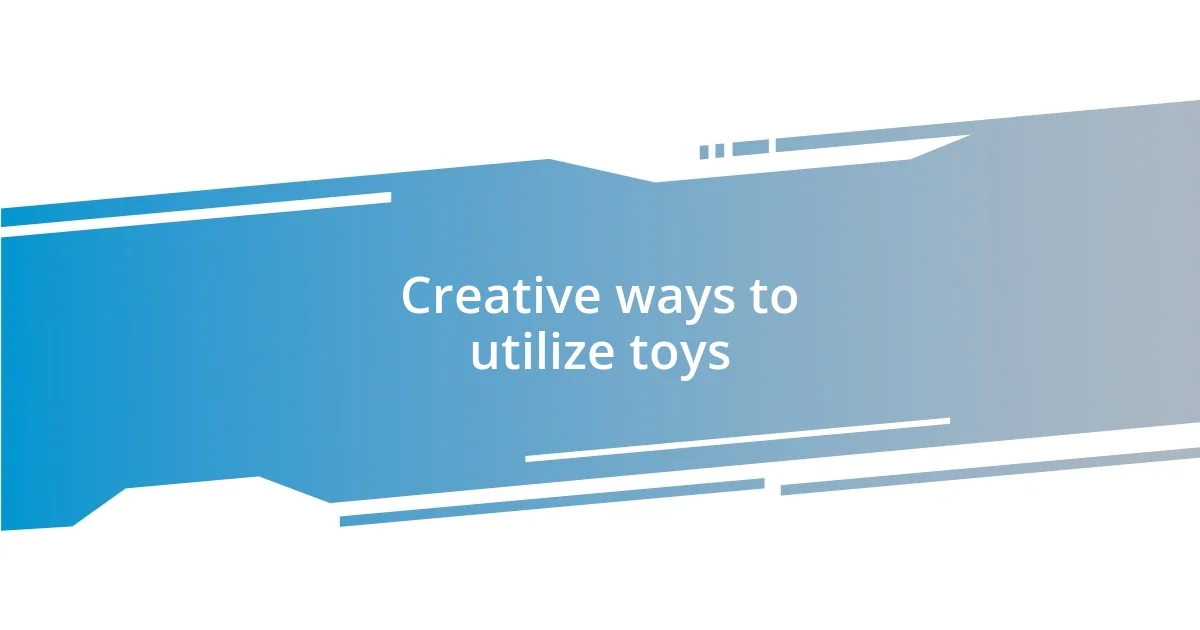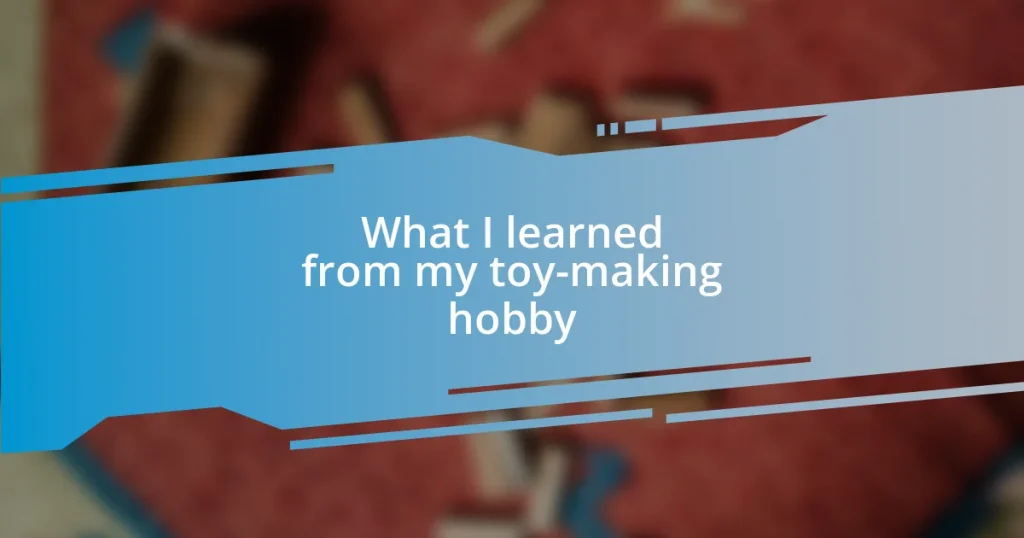Key takeaways:
- Toys are essential for child development, fostering creativity, problem-solving, social skills, and emotional expression during play.
- Selecting age-appropriate toys enhances developmental benefits, guiding children through stages with suitable activities that encourage growth and curiosity.
- Engaging in purposeful play, such as storytelling and sensory activities, not only makes learning enjoyable but also boosts confidence and collaboration among children.

Importance of toys in development
Toys are more than just playthings; they are vital tools for a child’s development. I remember watching my niece immerse herself in a simple building block set, her face lighting up with every creation she crafted. In that moment, I realized how these toys not only foster creativity but also enhance problem-solving skills—skills that children will rely on throughout their lives.
Think about it: when kids engage with toys, they’re learning vital social skills without even realizing it. I’ve seen my nephew negotiate the rules of a board game with friends, demonstrating patience and cooperation. What could be more rewarding than watching them grow in confidence as they navigate social dynamics through play?
Moreover, toys often serve as gateways to emotional expression. One afternoon, I found my daughter quietly playing with her dolls, whispering stories of friendship and conflict. It struck me how those moments offered her a safe space to explore her own feelings. Have you ever noticed how play can mirror real-life situations? It’s fascinating how children often process their emotions through the stories and scenarios they create with their toys.

Choosing age-appropriate toys
Choosing toys that align with a child’s developmental stage is crucial for maximizing their benefits. I remember when I selected toys for my young son; I was always drawn to those that matched his age. For instance, soft stacking rings were perfect for his tiny hands and developing motor skills, while a simple puzzle at a later stage helped him navigate logical thinking. It was rewarding to see how each toy spurred his growth and curiosity.
Here are some tips to remember when selecting age-appropriate toys:
- Infants (0-12 months): Opt for soft, colorful rattles and sensory toys that stimulate sight and sound.
- Toddlers (1-3 years): Look for shape sorters and push-and-pull toys that encourage movement and basic problem-solving.
- Preschoolers (3-5 years): Choose building sets and imaginative play toys, like dolls or action figures, to foster creativity and social skills.
- Early School Age (5-7 years): Include board games and crafts that boost cooperation and critical thinking abilities.
When I started selecting toys not just for entertainment but for their developmental value, I noticed my children engaging with them in ways I hadn’t anticipated. It became a joy to watch them explore new concepts and skills through play—each toy was a stepping stone in their journey of growth.

Engaging in playtime with purpose
Engaging in playtime with a purpose has transformed the way I view toys and their role in a child’s development. Just the other day, I set up a playdate where my kids explored different art supplies. Watching them completely engrossed in painting and collaging reminded me that creative activities boost not just fine motor skills but also allow children to express their feelings. Have you ever found art to be a cathartic outlet? For my children, it’s like a window into their imagination, fostering a sense of accomplishment as they create something uniquely their own.
As I reflect on my experiences, I can’t help but recall those moments when I joined my kids in their imaginative play. One afternoon, we built a makeshift fort using blankets and cushions. In that space, their laughter filled the air, and I watched as they transformed from children into explorers battling dragons. This reminded me of how crucial imaginative play is in developing not just creativity, but also resilience and teamwork. Isn’t it incredible how play can shape their ability to confront challenges?
Let’s not overlook the importance of integrating learning into these playful experiences. For instance, during a simple game of math bingo, I noticed my daughter developing a keen sense of numbers while having fun. It made me realize how blending education and play encourages curiosity and learning retention. What strategies have you used to make learning enjoyable for your kids? Emphasizing this kind of purposeful play can lead to lasting benefits for their growth.
| Type of Play | Purpose & Benefits |
|---|---|
| Creative Play | Enhances emotional expression and fine motor skills. |
| Imaginative Play | Develops teamwork and resilience while boosting creativity. |
| Educational Play | Encourages learning retention and curiosity through fun activities. |

Encouraging social skills through toys
When I think about how toys can nurture social skills, I remember playdates filled with laughter and learning. Once, I organized a tea party with my child’s dolls, inviting friends to join in. As they filled their cups and served imaginary pastries, I saw them naturally develop conversational skills, share ideas, and negotiate roles. It was fascinating to watch how a simple toy could foster communication and cooperation among kids, as they learned to express their feelings and thoughts in a safe space.
Role-playing games also opened up new avenues for social interaction in my household. I distinctly recall an afternoon when my kids found a box of costumes and started creating their own characters. While playing superheroes, they not only engaged with each other but also explored empathy and problem-solving. Have you ever noticed how a child’s ability to take on a character can lead to a deeper understanding of different perspectives? I saw this firsthand, as my children navigated conflicts, learning to understand both their feelings and those of their peers.
Furthermore, board games have played a pivotal role in teaching turn-taking and patience. I remember introducing a simple game to my kids where they had to wait for their turn to roll the dice. The excitement that buzzed in the room showed me that these games do more than just entertain—they create vital opportunities for children to practice essential social skills. What experiences have you had with games in shaping your child’s social development? Each session around the table transformed into a mini-lesson on respect and cooperation, highlighting the incredible power of play in developing relationships.

Creative ways to utilize toys
When it comes to toys, I have found that repurposing them for different activities adds a refreshing twist to playtime. For example, we turned our building blocks into sorting tools, allowing my children to categorize shapes and colors while having fun. It’s amazing how a simple shift in perspective can transform a toy’s purpose and deepen their learning. Have you ever tried mixing activities with toys you already have? It can spark a newfound enthusiasm for them.
I often utilize toys in storytelling sessions, blending the worlds of imagination and learning. Recently, my kids and I created a puppet show using their stuffed animals as characters. As they narrated their stories, I saw their confidence soar, and it became a wonderful opportunity for me to introduce new vocabulary and concepts. It makes me smile to think about how they absorbed lessons while fully engrossed in their characters. Isn’t it fascinating how stories come to life through play?
Additionally, I’ve discovered the joy of incorporating sensory play with toys such as water beads and kinetic sand. I set up a small sensory table, mixing in their favorite action figures to create a themed adventure. Watching them dive into the sensory experience not only captivated their attention but also enhanced their fine motor skills as they scooped and poured. Have you noticed how sensory toys can also be calming? For my children, these moments served as a refuge after a busy day, allowing them to express themselves freely and creatively.

Evaluating the impact on development
Evaluating the impact of toys on child development reveals distinct benefits that go beyond simple entertainment. I remember one afternoon when my child played with a set of stacking cups, and it struck me how much they were engaging in problem-solving. Watching them experiment with balance and gravity brought a sense of wonder and learning. Isn’t it incredible how something as basic as colorful cups can spark curiosity and cognitive growth?
Another crucial aspect I’ve noticed is the role of toys in emotional development. There was a time when my child encountered a toy that mimicked caregiving—a baby doll that cried when it needed attention. Observing them comfort and care for it, I saw a genuine display of empathy unfold. Have you ever experienced a moment where a toy helped your child express their feelings? It made me realize that play is an effective outlet for kids to mirror emotions and understand their own feelings better.
Examining the social dynamics during play also provides valuable insights. Once, I observed my kids engage in a game of make-believe, creating a whole world with their action figures. The back-and-forth negotiations on how to play out the scene highlighted not only their creativity but also their growing ability to collaborate and compromise. Can you think of a time when your child surprised you with their social finesse during play? That moment reminded me that the lessons learned through toys resonate deeply, shaping their interpersonal skills for years to come.
















